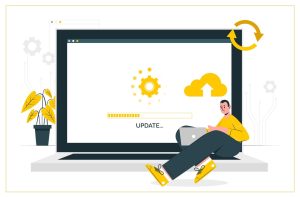How To Build A WebRTC Video Chat Application: A Step-by-Step Guide

A potent open-source technology called WebRTC (Web Real-Time Communication) enables real-time audio and video communication within web browsers without the use of plugins or any extra applications. WebRTC has become quite popular recently and has completely changed how we connect online. For developers, creating a WebRTC video chat application may be a fun and gratifying endeavor. This post will walk you through the process of building a WebRTC video chat application from scratch.
What Is WebRTC?
It’s crucial to understand the fundamentals of WebRTC before getting started on the development process. There are three main WebRTC APIs:
- MediaStream. This API offers audio and video feeds as well as access to the user’s camera and microphone.
- RTCPeerConnection. The RTCPeerConnection API facilitates the creation of a peer-to-peer connection between two users for real-time communication.
- RTCDataChannel. While unrelated to video chat, RTCDataChannel enables users to share any type of data.
The help of professionals can be useful in creating a WebRTC video chat application: https://trembit.com/industries/webrtc-development.html.
How to Create a WebRTC Video Chat App?
Organizing the Project
Setting up your project directory and necessary files is the first step. To construct a video chat application, you’ll need HTML, CSS, and JavaScript files. To code the program, use your chosen text editor or Integrated Development Environment (IDE). To guarantee simple navigation during the development process, arrange your files cleanly.
HTML Structure and Styling
Start by establishing the fundamental framework for your video chat application in the HTML file. For both the local and distant users’ video streams, create containers. Include buttons to activate the microphone and camera, stop the video call, and start the video call. Give these items distinctive identities so that your JavaScript code can quickly refer to them.
Next, customize your video chat program with CSS to give it a pleasing appearance. Adjust the size of the video containers, alter the layout, and add any further design components as necessary. The whole user experience is improved with a clear and user-friendly interface.
Making Use of User Media
Access to the user’s camera and microphone is the foundation of every video chat application. To request access to these media devices, use the MediaStream API. Once authorized, use the user’s camera feed to build the local video stream. To display the user’s video feed, show the video stream in the local video container.
If you have difficulty with this or any other step, you can get detailed advice here: https://trembit.com/.
Creating the Connection
Peer-to-peer connections that allow for real-time communication between users are where WebRTC’s true magic resides. To establish connections, use the RTCPeerConnection API. This API makes connection negotiation and setup easier.
You’ll need to use signaling to start the connection. Signaling is the procedure through which users exchange connection information to effectively establish the connection. The process of signaling can be accomplished in several ways, including by utilizing a signaling server, WebSockets, or third-party libraries like Socket.io.
Transmission and Reception of Video Streams
You may now set up features to send and receive video streams between users after the connection has been established and signaling is in place. Video from the distant user is streamed to the local user, and vice versa. On the receiver’s side, show the remote video in the relevant container.
Keep in mind to gracefully manage any connection dropouts or network outages. When a connection is lost or regained, provide reconnect procedures and give users feedback.
Additional Features

You may now improve your application by including a few fun new features:
- Screen Sharing. Enable screen-sharing so that participants in a video conference can share their displays. Team collaboration and remote presentations both greatly benefit from this capability.
- Text Chat. Add a text chat function in addition to the video broadcast. Users may use this to improve communication and teamwork by exchanging texts while video conferencing.
- Recording. A recording option that enables users to capture their video calls for later review or sharing with others should be added.
Conclusion
The process of building a WebRTC video chat application does not need to be difficult. You can create a basic video chat application and provide consumers with a flawless real-time communication experience by following these five easy steps. To satisfy the changing demands of users, don’t forget to test, optimize, and continually develop your application. So gather your development resources and start this thrilling voyage of creating your very own WebRTC video chat application.





